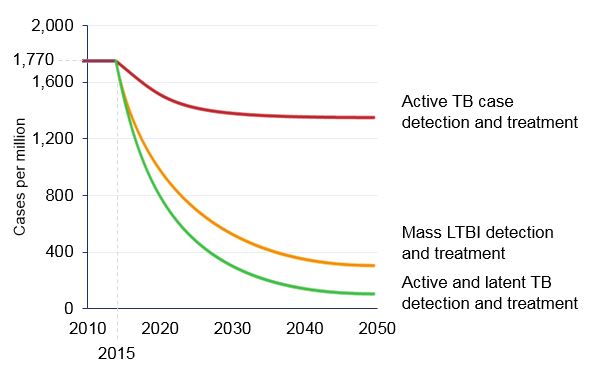お問い合わせ
-
各種お問い合わせはこちらから www.quantiferon.com/jp/contact-us/

TB is an airborne, highly contagious, infectious disease caused by Mycobacterium tuberculosis. Most frequently, TB affects the lungs, however, it can also cause disease in any part of the body, such as the lymph nodes, bones, brain, organs and eyes. TB is a serious disease that kills about 1.5 million people each year worldwide (1). TB infection begins without symptoms before becoming active. This inactive carrier state is called latent TB infection (LTBI) and can persist for weeks, months or years before developing into active contagious disease. Symptoms of active TB include chronic cough, fever, unexplained weight loss and, if severe, night sweats and even coughing up blood.
The good news is that TB disease is preventable and curable. If TB infection is recognized early, effective preventive treatment can be provided by your doctor. If TB is active, a treatment of multiple drugs is required for a minimum of 6 months that will usually cure the disease and lead to a full recovery.
Active tuberculosis is contagious and mainly transmitted through the air. The bacteria are spread through the air by an infected person sneezing, coughing or speaking, and then nearby people inhaling the droplets.
A distinction is made between latent and active tuberculosis. LTBI can persist for weeks, months or years before developing into active disease. Although LTBI is not contagious, there is a ~10% average lifetime risk of it becoming active. According to the World Health Organization, up to 1/3 of the world’s population is infected with TB.’s immune system and symptoms (e.g., cough, night sweats and weight loss) appear. A person who has active pulmonary TB is contagious.
Diagnosing LTBI, and preventive treatment, can significantly reduce the risk of disease, and prevent outbreaks from recent transmission. On a global level, achieving a significant reduction in the burden of TB cases cannot be achieved without also including the detection and treatment of LTBI (Figure 1)(2).

Prioritized or targeted TB screening focuses on screening individuals and populations at highest risk of being infected, progressing or reactivating TB disease, or having both risks present. The purpose of TB screening is to find cases at an early asymptomatic phase that is easily curable and find LTBI among individuals who may benefit from preventive treatment. The World Health Organization recommends LTBI testing and treatment for populations at the highest risk (Table 1).
Table 1. Recommended populations for LTBI testing and treatment (1)
| 結核発病リスクの高いグループ | その他優先される高リスクグループ |
|---|---|
| 肺結核患者との接触者 | 医療従事者 |
| HIV感染者 | 刑事施設被収容者 |
| 抗TNFα治療開始患者 | 移民 |
| 透析患者 | 密集した環境の住民 |
| 臓器移植患者 | 違法薬剤の使用者 |
There are two types of tests that can detect tuberculosis infection: the tuberculin skin test (TST), also known as the Purified Protein Derivative (PPD) test, and a blood test such as QuantiFERON-TB Gold (QFT). With the TST, tuberculin is injected into the skin of the lower arm and another visit to the doctor for a physical examination is necessary after a few days. If you are infected with TB, a raised lump will develop at the site where the tuberculin was injected. A previous Bacille Calmette-Guérin (BCG) vaccination is likely to cause a false positive result (3). Furthermore, you may also experience severe itching at the puncture site.
With a TB blood test like QFT, a small blood sample is taken and then tested in a laboratory. There is no need to return to the doctor to get a result. Reliable results can be obtained within 24 hours. QFT provides the convenience of a single visit, and confidence in an objective, laboratory-based result.

Product claims may differ from country to country based on regulations and approvals. Contact your country representative for further details.
各種お問い合わせはこちらから www.quantiferon.com/jp/contact-us/